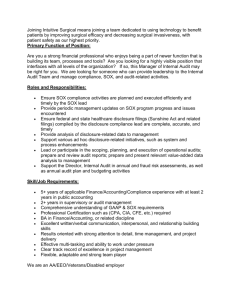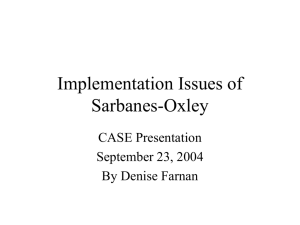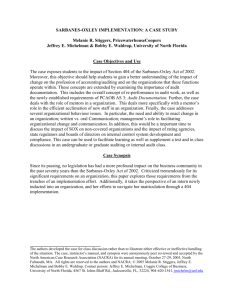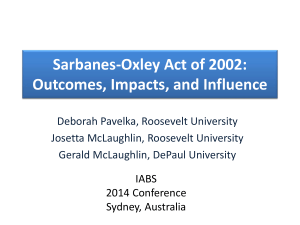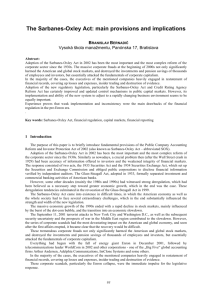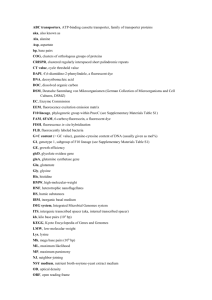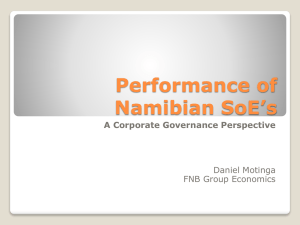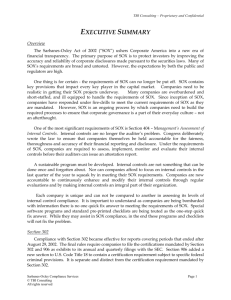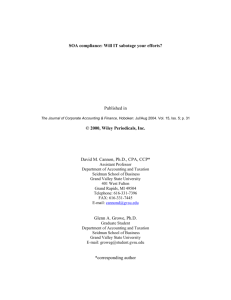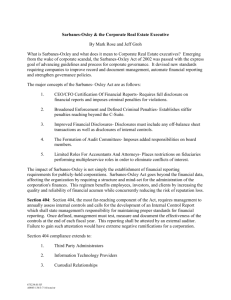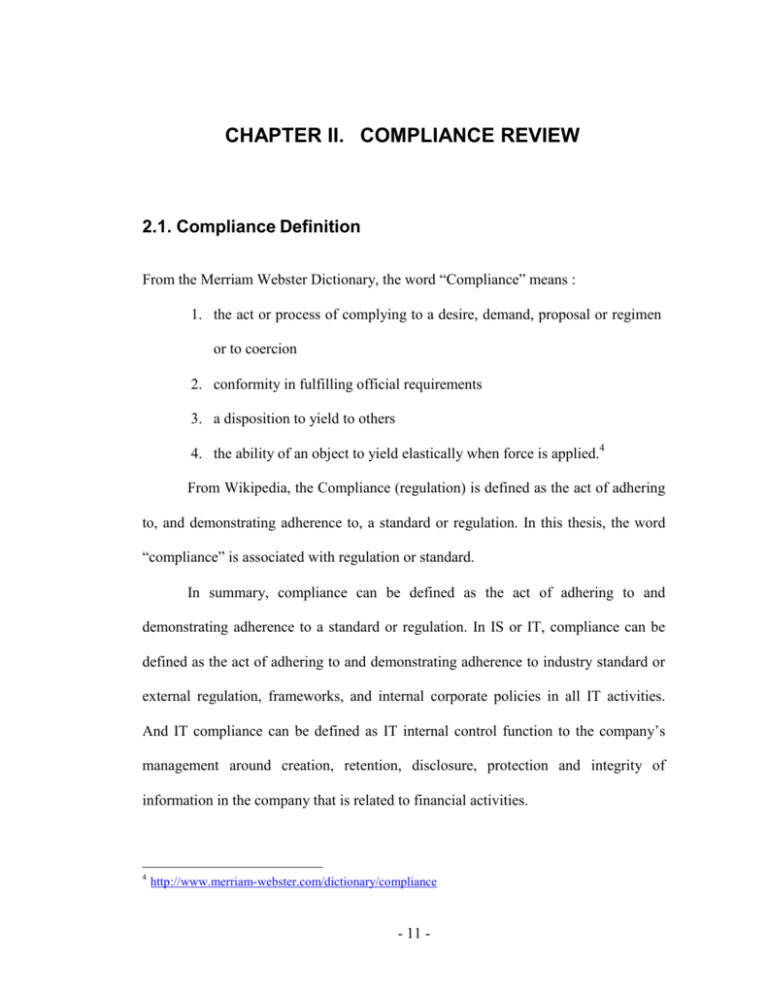
CHAPTER II. COMPLIANCE REVIEW
2.1. Compliance Definition
From the Merriam Webster Dictionary, the word “Compliance” means :
1. the act or process of complying to a desire, demand, proposal or regimen
or to coercion
2. conformity in fulfilling official requirements
3. a disposition to yield to others
4. the ability of an object to yield elastically when force is applied.4
From Wikipedia, the Compliance (regulation) is defined as the act of adhering
to, and demonstrating adherence to, a standard or regulation. In this thesis, the word
“compliance” is associated with regulation or standard.
In summary, compliance can be defined as the act of adhering to and
demonstrating adherence to a standard or regulation. In IS or IT, compliance can be
defined as the act of adhering to and demonstrating adherence to industry standard or
external regulation, frameworks, and internal corporate policies in all IT activities.
And IT compliance can be defined as IT internal control function to the company’s
management around creation, retention, disclosure, protection and integrity of
information in the company that is related to financial activities.
4
http://www.merriam-webster.com/dictionary/compliance
- 11 -
12
2.2. IT Compliance category
According to Financial Insights (an International Data Company specializing
in the Financial Services sector), IT compliance can generally be categorized into the
following three distinct areas (as described in Figure 2.1) :
1. Information Security
2. Content Management
3. Policies and Procedures
Figure 2.1. Key Components of IT Compliance
2.2.1. Information Security
Information security is the backbone of any compliance infrastructure.
Without an effective security controls, financial institution risk exposing proprietary
13
information and personal customer information to theft or unauthorized access. Theft
on customer information can lead to fraud, money laundering, or even financing of
illicit activities.
Achieving a secure IS environment is a dynamic and continuous process. The
company must continually assess the possible Security risk and continually improve
the security controls to manage the security risk.
2.2.2. Content Management
Content Management is about managing the company’s data or information.
A good content management should make: the data to be available every time it is
needed, the data can be easily retrieved, the data can be accessed only by the
authorized person.
A good content management should cover 3 things5 :
1. Availability: Will the information systems on which the business is heavily
dependent be available for the business at all times when required? Are the
systems well protected against all types of losses and disasters?
2. Confidentiality: Will the information in the systems be disclosed only to those
who have a need to see and use it and not to anyone else?
5
http://www.isaca.org/Template.cfm?Section=IT_Audit_Basics&Template=/ContentManagement/Cont
entDisplay.cfm&ContentID=11223
14
3. Integrity: Will the information provided by the systems always be accurate,
reliable and timely? What ensures that no unauthorized modification can be
made to the data or the software in the systems?
Bad content management can lead data/information leakage in the company.
That may lead also to fraud, money laundering, even financing of illicit activities.
To achieve a good content management, the company must identify all the
data information in the company. Then, company should have a control for each data
or information. This will reduce the risk of leakage data or information.
2.2.3. Policies and Procedures
All processes and activities have to have a standard procedure or in a
company level, a policy. This is very important in order to achieve a compliant
environment. Policies and procedures should be created by the related person. Input
and endorsement are critical to achieve a compliant procedures and policies that best
suit the organization.
The organizations must properly train and inform their employees of any
policies changed. Participation across organization is also important and should
include IT organizations, legal departments and business stakeholders.
15
2.3. The IT Compliance challenges
A
research
sponsored
by
the
Security
Compliance
council
(www.securitycompliance.com) indicates that the key challenges that organizations
face in meeting the requirements for IT Compliance are, as follow :
•
Growing complexity of managing compliance with multiple regulations
•
Increasing costs of compliance
•
Risks posed by noncompliance
2.3.1. Growing complexity of managing compliance with
multiple regulations
From the survey of 400 respondents represented enterprise-level companies across a
wide range of industries. More than half of them were from companies with 10,000 or
more employees. About half held IT management or executive positions. The
remainder included consultants/systems integrators or held other IT titles.
Ranking of IT objectives in terms of the most critical priority 6
1. Reducing IT costs
2. Regulatory compliance
3. Improving availability and performance of business services
4. Incident and problem management
5. Change management
6. Virtualization
6
http://www.ebizq.net/topics/business_service_management/features/12276.html?page=2
16
7. Capacity planning
8. IT budgeting and chargeback
9. Data center consolidation
10. IT risk management
11. Improving internal user satisfaction
12. Service desk consolidation
13. IT-enabled process improvement (ITIL, COBIT, ISO/IEC 20000, etc.)
14. Asset and vendor management
15. Cloud computing (may also be part of a virtualization initiative)
It is completely obvious that IT compliance is holding a significant rank of IT
objectives (2 out of 15). And according to Ernst & Young, the most pressing
challenges that companies face today:7
•
Internal control,
•
Corporate governance,
•
Risk management, and
•
Regulatory compliance
With so many organizations struggling to run IT compliance by meeting the
internal and external auditors, hat must satisfy multiple regulatory mandates. On
average more than one third (34 percent) of IT resources are being spent to meet
multiple regulatory demands, according to research sponsored by the Security
Compliance council.
7
https://eyo-iis-pd.ey.com/drivinggrowth/unprotected/downloads/Risk_Post_IPO.pdf Ernst & Young,
The Essential Guide to: Risk Post – IPO, 2006
17
The analyst firm AMR research for example, estimates that compliance
spending will exceed $80 billion over the next five years and $15.5 billion this year.
For 2005, AMR research says companies spent $5.8 billion on meeting the SOX
requirements alone.8
2.3.2. Increasing Cost of Compliance
Compliance is an issue with which all financial institutions must grapple.
According to financial insights, US Financial institutions (including banks, capital
market firms and insurance companies) spent almost $3.7 billion on compliance
solutions in 2005. This figure is expected to grow at a five-percent compounded
annual rate through 2010.9
There are several factors that contribute to the increasing costs of compliance
in term of IT budget and resources. Manual and ad hoc processes in IT compliance
process creating labor-intensive activities that are expensive, error-prone and not
easily repeatable.
Beside, inconsistent process among business units and geographies also create
more time used to prepare an audit, more time spend by external auditors to evaluate
control environment. Longer audit is mean higher audit fees. Inconsistent process
also may create duplication or redundant work, which requires multiple efforts to test,
measure and report on the same IT control.
8
Copyright Association of Records Managers and Administrators Jan/Feb 2006, Provided by ProQuest
Information and Learning Company. All rights Reserved.
http://findarticles.com/p/articles/mi_qa3937/is_200601/ai_n17188931/
9
http://eval.symantec.com/mktginfo/enterprise/yellowbooks/it_compliance_03_2006.en-us.pdf
18
2.4. Sarbanes-Oxley
Sarbanes-Oxley is the most common standard used in Compliance. The rule
was started on 2002. Enron, Arthur Andersen, WorldCom, Tyco, Adelphia. These
companies have become household names mostly because of their past display of
corporate greed, fraud and accounting improprieties. The offenses of these few
organizations are not representative of the majority of more than 15,000 public
companies in the United States, yet the results of their abuses are far reaching. Thus,
on July 30th, the U.S. Congress declared the Sarbanes-Oxley Act of 2002. 10
Sarbanes-Oxley is named after two person, Senator Paul Sarbanes (D-Md)
and Congressman Michael Oxley (R-Oh). Sarbanes-Oxley Act is also known by
several names, including :
− Public Company Accounting Reform and Investor Protection act of 2002
− SOA
− SOX
− SarbOx.11
The act was signed into law to improve the accuracy and transparency of
financial reports and corporate disclosures, as well to reinforce the importance of
corporate ethical standards. As a result, the SEC (Securities and Exchange
Commission) issued rules outlining the provisions of the Act. In addition, the NYSE
(New York Stock Exchange), Amex (American Stock Exchange) and the Nasdaq
10
Marchetti, Anne M, 2005, Beyond Sarbanes-Oxley compliance : effective enterprise risk
management, John Wiley & Sons, Inc
11
Anand, Sanjay, 2007, Essentials of sarbanes-oxley, John Wiley & Sons, Inc
19
Stock Market, have all significantly modified the standards for listing stocks on their
exchanges. 12
SOA is the most significant legislation impacting the accounting profession. It
addresses a wide range of matters range relevant to publicly held issuers and their
auditors, including the auditor oversight and independence, corporate responsibility
for financial reports, and enhanced financial disclosures. SOA is composed 11 titles :
I.
Public Company Accounting Oversight Board
II.
Auditor Independence
III.
Corporate Responsibility
IV.
Enhanced Financial Disclosures
V.
Analyst Conflicts of Interest
VI.
Commission Resources and Authority
VII.
Studies and Reports
VIII. Corporate and Criminal Fraud Accountability
12
IX.
White Collar Crime Penalty Enhancement
X.
Corporate Tax Return
XI.
Corporate Fraud and Accountability
Solomon, Jill, 2007, Corporate governance and accountability, 2nd Edition, Wiley.
20
SOA is designed to reassure shareholders that their investments are being
protected from scandal and deception. Thus SOA was written in the spirit of three key
principles (figure 2.2) : integrity, accuracy and accountability.
Accountability
Re-established
Investor Trust
Accurancy
Integrity
Figure 2.2. SOA Key Principles
These three principles are the main points that should have to be fulfilled in
implementing SOA compliance in a company.
The most important section from SOX to Financial services company is the
SOX 302, SOX 906 and SOX 404. SOX 302 stated about the Corporate
Responsibility for Financial Report, “The CEO and CFO of each issuer shall prepare
a statement to accompany the audit report to certify the ‘appropriateness of the
financial statements and disclosures contained in the periodic report, and that those
financial statements and disclosures fairly present, in all material respects, the
operations and financial condition of the issuer.’ A violation of this section must be
knowing and intentional to give rise to liability”.
SOX 906 also stated about Corporate responsibility for financial reports and
also mention that the white collar that commit crime will get the penalty.
21
SOX 404 is specifically stated about the Management Assessment of Internal
control. The internal control stated here is the internal control that have influenced to
the company’s annual financial report (stated in SOX 302 and SOX 906).
2.4.1. Sarbanes-Oxley – Section 404 Overview
SOA Title IV consists of nine sections. It describes enhanced reporting
requirements for financial transactions, including off-balance-sheet transactions, proforma figures and stock transactions of corporate officers. It requires internal controls
for assuring the accuracy of financial reports and disclosures, and mandates both
audits and reports on those controls. It also requires timely reporting of material
changes in financial condition and specific enhanced reviews by the SEC or its agents
of corporate reports. The sections of title IV are:
Section 401. Disclosures in periodic reports
Section 402. Enhanced conflict of interest provisions
Section 403. Disclosures of transactions involving management and principal
stockholders
Section 404. Management assessment of internal control
Section 405. Exemption
Section 406. Code of Ethics for senior financial officers Section
407.
Disclosure of audit committee financial expert
Section 408. Enhanced review of periodic disclosures by issuers
Section 409. Real time issuer disclosures
22
SEC. 404. MANAGEMENT ASSESSMENT OF INTERNAL CONTROLS.13
(a) RULES REQUIRED.
The Commission shall prescribe rules requiring each annual report required by
section 13(a) or 15(d) of the Securities Exchange Act of 1934 (15 U.S.C. 78m or
78o(d)) to contain an internal control report, which shall :
(1) state the responsibility of management for establishing and maintaining an
adequate internal control structure and procedures for financial reporting; and
(2) contain an assessment, as of the end of the most recent fiscal year of the
issuer, of the effectiveness of the internal control structure and procedures of
the issuer for financial reporting.
(b) INTERNAL CONTROL EVALUATION AND REPORTING.
With respect to the internal control assessment required by subsection
(a) each registered public accounting firm that prepares or issues the audit report
for the issuer shall attest to, and report on, the assessment made by the
management of the issuer. An attestation made under this subsection shall be
made in accordance with standards for attestation engagements issued or
adopted by the Board. Any such attestation shall not be the subject of a
separate engagement.
Section 404 requires the Management to have an assessment of internal
control, main concern is to the financial reform. It also requires that all annual
financial reports include an Internal Control report to certify and explain those efforts
13
http://news.findlaw.com/hdocs/docs/ gwbush/sarbanesoxley072302.pdf
23
that have been made to ensure the integrity and accuracy of the financial information.
This rule (b) is purposely mention that a Compliance section is needed as the key of
internal control. It also can be concluded the same for IT Compliance in IT systems.
Section 404 doesn’t directly relate to IT Compliance implementation in the
company explicitly. But by having an independent IT compliance section and
implement IT compliance in the IT Systems, management can sure that the internal
control on financial transaction done by IT systems is in place.
2.5. SOX 404 Internal Control Framework
Figure 2.3. Processes to Achieve SOA Compliance
Companies generally implement SOA compliance by adopting the internal control
framework (figure 2.3). The process are included :14
− Assessment and improvement of internal controls
− Development of risk management programs
− Reporting processes
14
Anand, Sanjay, Essentials of Sarbanes-Oxley, John Wiley & Sons, Inc, 2007
24
2.5.1. Assessment and Improvement of Internal Controls
To implement SOX 404 compliance, first the IT compliance has to do self
assessment. To do the assessment, IT Compliance has to define the internal control
areas for the assessment.
In assessing the company’s internal control, usually COSO’s (Committee of
Sponsoring Organizations of the Treadway Commission) framework is used. for
financial and IS auditing. COSO’s framework (figure 2.4) consists of15 :
1. Internal Environment – The internal environment encompasses the tone of an
organization, and sets the basis for how risk is viewed and addressed by an
entity’s people, including risk management philosophy and risk appetite,
integrity and ethical values, and the environment in which they operate.
2. Objective Setting – Objectives must exist before management can identify
potential events affecting their achievement. Enterprise risk management
ensures that management has in place a process to set objectives and that the
chosen objectives support and align with the entity’s mission and are
consistent with its risk appetite.
3. Event Identification – Internal and external events affecting achievement of an
entity’s objectives must be identified, distinguishing between risks and
opportunities. Opportunities are channeled back to management’s strategy or
objective-setting processes.
15
http://www.coso.org/Publications/ERM/COSO_ERM_ExecutiveSummary.pdf
25
4. Risk Assessment – Risks are analyzed, considering likelihood and impact, as
a basis for determining how they should be managed. Risks are assessed on an
inherent and a residual basis.
5. Risk Response – Management selects risk responses – avoiding, accepting,
reducing, or sharing risk – developing a set of actions to align risks with the
entity’s risk tolerances and risk appetite.
6. Control Activities – Policies and procedures are established and implemented
to help ensure the risk responses are effectively carried out.
7. Information and Communication – Relevant information is identified,
captured, and communicated in a form and timeframe that enable people to
carry out their responsibilities. Effective communication also occurs in a
broader sense, flowing down, across, and up the entity.
8. Monitoring – The entirety of enterprise risk management is monitored and
modifications made as necessary. Monitoring is accomplished through
ongoing management activities, separate evaluations, or both.
Figure 2.4. COSO Framework 2004
26
The major elements / internal control area of IS audit can be broadly classified as16 :
1. In Physical and environmental review - This includes physical security, power
supply, air conditioning, humidity control and other environmental factors.
2. System administration review - This includes security review of the operating
systems, database management systems, all system administration procedures
and compliance.
3. Application software review - The business application could be payroll,
invoicing, a web-based customer order processing system or an enterprise
resource planning system that actually runs the business. Review of such
application software includes access control and authorizations, validations,
error and exception handling, business process flows within the application
software and complementary manual controls and procedures. Additionally, a
review of the system development lifecycle should be completed.
4. Network security review - Review of internal and external connections to the
system, perimeter security, firewall review, router access control lists, port
scanning and intrusion detection are some typical areas of coverage.
5. Business continuity review - This includes existence and maintenance of fault
tolerant and redundant hardware, backup procedures and storage, and
documented and tested disaster recovery/business continuity plan.
16
Sayana,S. Anantha, CISA,CIA, "IT Audit Basics", Information Systems Control Journal, Vol.1,
2002.
http://www.isaca.org/Template.cfm?Section=IT_Audit_Basics&Template=/ContentManagement/Cont
entDisplay.cfm&ContentID=11223
27
6. Data integrity review - The purpose of this is scrutiny of live data to verify
adequacy of controls and impact of weaknesses, as noticed from any of the
above reviews. Such substantive testing can be done using generalized audit
software (e.g., computer assisted audit techniques).
2.5.2. Development of risk management programs
After the assessment of internal control in IT systems, IT compliance will
have to define risks that may be occurs if the internal control not on place.
The risks if internal control is not on place :17
1. Loss of Integrity.
System and data integrity refers to the requirement that information be
protected from improper modification. Integrity is lost if unauthorized
changes are made to the data or IT system by either intentional or accidental
acts. If the loss of system or data integrity is not corrected, continued use of
the contaminated system or corrupted data could result in inaccuracy, fraud, or
erroneous decisions.
Also, violation of integrity may be the first step in a successful attack against
system availability or confidentiality. For all these reasons, loss of integrity
reduces the assurance of an IT system.
2. Loss of Availability.
17
http://csrc.nist.gov/publications/nistpubs/800-30/sp800-30. Risk Management Guide for Information
Technology Systems
28
If a mission-critical IT system is unavailable to its end users, the
organization’s mission may be affected. Loss of system functionality and
operational effectiveness, for example, may result in loss of productive time,
thus impeding the end users’ performance of their functions in supporting the
organization’s mission.
3. Loss of Confidentiality.
System and data confidentiality refers to the protection of information from
unauthorized disclosure. The impact
of
unauthorized disclosure of
confidential information can range from the jeopardizing of national security
to the disclosure of Privacy Act data. Unauthorized, unanticipated, or
unintentional disclosure could result in loss of public confidence,
embarrassment, or legal action against the organization.
After IT risks are defined, IT compliance will treat the risk in order to
improve performance or based on the management’s will. Risk treatments are
categorized as below18 :
1. Avoidance – company exit the activities due to the risk. E.g. exiting a product
line, declining expansion, or selling a division.
2. Reduction – company try to reduce the frequency and or severity at business
activity and decision making.
18
https://eyo-iis-pd.ey.com/drivinggrowth/unprotected/downloads/Risk_Post_IPO.pdf Ernst & Young,
The Essential Guide to: Risk Post – IPO, 2006
29
3. Sharing – company try to reduce the frequency and or severity by transferring
or sharing some or all risk. The common techniques are by buying insurance,
hedging the transactions, or outsource the activity.
4. Acceptance – No action regarding the frequency and severity of inherent risk.
2.5.3. Reporting processes
After treating Risk, IT compliance has to create reports of the compliance process.
This reporting process is also include collecting all of the reports and evidences on IT
operations that are being controlled. These reports will be used for report to the
company management. This report makes the management know the condition of its
IT internal control and can make better decision to direct the company in the future.
The report will also be as a fulfillment of SOS section 404.

